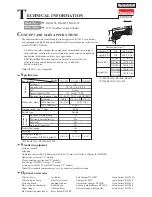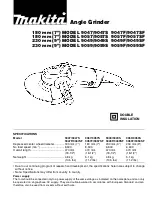
9
ENGLISH
Do not
use sandpaper discs and grinding wheels
other than those with depressed center.
Do not
use the tool in wet conditions or environments
in the presence of flammable liquids or gases.
This heavy-duty angle grinder is a professional power
tool.
Do not
allow children to come in contact with this
tool. Inexperienced operators are required to use this
tool under supervision.
Electrical Equipment Safety
Only one voltage is applicable to this tool. Be sure
to check that the power suuply corresponds to the
voltage on the rating plate.
Your Stanley tool is equipped with double
insulation, hence, it does not require to be
earthed.
When the power cord is damaged, have it sent to a
Stanley service center for replacement to specially
prepared cables.
Using Extension Cords
If an extension cord is required, please select a
3-phase extension cord that has been inspected
and matches the input power (see Technical Data) of
this tool. The minimum conductor size is 1.5mm2,
maximum length is 30 meters.
When using a cable reel, be sure to pull out all the
cables.
Assembly and Adjustment
WARNING:
To minimize the danger of
serious personal injury, please switch
off the tool power and disconnect all
plugs before adjusting or removing/
installing any accessory.
Before
reassembling the tool, press and release
the trigger switch to make sure the tool is
already switched off.
Attaching and Removing the Wheel
Guard (Fig. 2)
WARNING:
To minimize the danger of
serious personal injury, please switch
off the tool power and disconnect all
plugs before adjusting or removing/
installing any accessory.
Before
reassembling the tool, press and release
the trigger switch to make sure the tool is
already switched off.
ATTACHING THE GUARD
1. Place the angle grinder on a work bench,
groove facing up.
2. Bring the flange of the guard (c) collar over the
groove (i) of the gear housing.
3. Turn the guard (c) counterclockwise by 150
degrees.
4. Make sure that the screws (k) are tightened.
REMOVING THE GUARD
1. Loosen the screws (k) on the guard collar.
2. Pull up the guard (c).
WARNING:
Do not operate the tool
when the safety guard is not in place.
Note:
Refer to the
grinding accessories chart
at
the end of this section for accessories that can be
used together with this angle grinder.
Attaching and Removing Grinding
Wheels (Fig. 3, 4)
WARNING:
Do not use damaged
grinding wheels.
1. Place the tool on a work bench, groove facing
up.
2. Attach the inner flange (d) correctly on the
output shaft (e) (Fig. 3).
3. Place the grinding wheel (f) on the inner flange
(d). When attaching a grinding wheel with a
raised center, make sure that the raised center
(g) faces the inner flange (d).
4. Tighten the outer flange (h) until the output shaft
(e) (Fig. 4). When attaching the grinding wheel,
the ring on top of the outer flange (h) must face
the wheel.
5. Press the spindle lock (b) and prevent the
spindle (e) from rotating until it locks in place.
6. Use the pin spanner to tighten the outer flange
(h).
Preparation Before Use
• Attach the safety guard and appropriate
abrasive or grinding wheels. Do not use
abrasive or grinding wheels that are overly worn.
• Make sure that the inner and outer flanges are
attached correctly.
• Make sure that the abrasive or grinding wheels
are rotating in the direction of the arrows on the
accessories and tool.






































